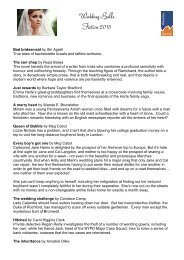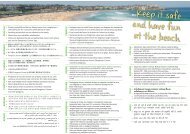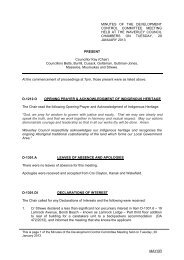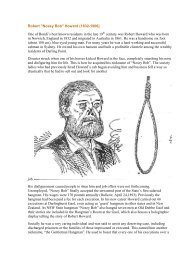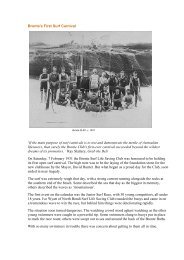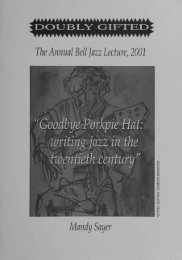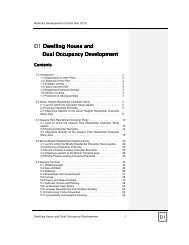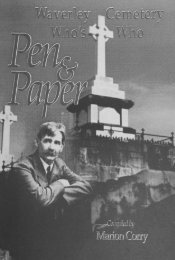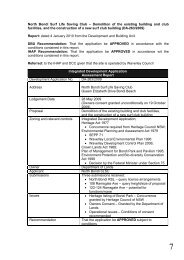Bronte House: Waverley's oldest property - Waverley Council
Bronte House: Waverley's oldest property - Waverley Council
Bronte House: Waverley's oldest property - Waverley Council
You also want an ePaper? Increase the reach of your titles
YUMPU automatically turns print PDFs into web optimized ePapers that Google loves.
<strong>Bronte</strong> <strong>House</strong>: <strong><strong>Waverley</strong>'s</strong> <strong>oldest</strong> <strong>property</strong><br />
<strong>Bronte</strong> <strong>House</strong>, 1986<br />
<strong>Bronte</strong> <strong>House</strong>’s story begins in 1836 when William Mortimer Lewis, Colonial Architect,<br />
bought 42 acres of land at Nelson Bay. He began a house on his land but, when an economic<br />
depression hit in 1843, was forced to sell the <strong>property</strong> before its completion.<br />
Robert Lowe, an English barrister and later NSW parliamentarian bought the <strong>property</strong> as a<br />
‘country residence’ and finished the house in 1845. He and his wife Georgiana were some of<br />
the <strong>Bronte</strong> <strong>House</strong>’s most charismatic inhabitants, despite only being in residence for four<br />
years.<br />
The house changed hands quickly over the next couple of years, until the Ebsworth family<br />
bought the <strong>property</strong> in 1882. They were the longest private owners of <strong>Bronte</strong> <strong>House</strong>, the<br />
family occupying the <strong>property</strong> over three generations.<br />
In 1948 the Ebsworths sold the house and its grounds to <strong>Waverley</strong> <strong>Council</strong>. The <strong>Bronte</strong><br />
branch of the Red Cross applied to <strong>Council</strong> to rent two small rooms and the kitchen at the<br />
rear of the <strong>property</strong>. <strong>Council</strong> agreed and the Red Cross had their home at <strong>Bronte</strong> <strong>House</strong> until<br />
1969. An evening card party was held by them each week to raise money for their rent.<br />
The house was fully restored by <strong>Council</strong> and is now leased out. Notable amongst recent<br />
lessees was Leo Schofield, whose love of the gardens is explored in his book The Garden at<br />
<strong>Bronte</strong>.<br />
<strong>Bronte</strong> <strong>House</strong> is designed in the picturesque style; its features include romantic circular and<br />
hexagonal corner turrets, deep bay windows, and pierced wooden tracery. A second story<br />
was added to the house in the 1880s.<br />
The house is built of sandstone with a slate roof. It has two fronts, one at the western
entrance and the other on the opposite side, with a stunning view over the ocean.<br />
The original approach to the house was by a gravel carriageway, now <strong>Bronte</strong> Road, which<br />
curved down the hill from Charing Cross, terminating in the circular drive still in front of the<br />
house.<br />
The estate to which <strong>Bronte</strong> <strong>House</strong> belonged was extensive. It included the cliff to the south<br />
of the house, where the <strong>property</strong>’s stables were located, <strong>Bronte</strong> Gully and <strong>Bronte</strong> Park and<br />
even the beachfront itself.<br />
You can view part of <strong>Bronte</strong> <strong>House</strong> and its entire garden on one of its open days, which are<br />
held four times per year.<br />
Sketch of bamboo in <strong>Bronte</strong> <strong>House</strong> garden by Georgiana Lowe (the bamboo was planted by her) c. 1845-1849.<br />
Georgiana Lowe’s sketches<br />
Georgiana Lowe was a skilful artist and enthusiastic gardener with knowledge of botany. She<br />
played the major role in the initial landscaping of the <strong>Bronte</strong> <strong>House</strong> gardens, incorporating<br />
native and exotic plants into picturesque walks.
She loved <strong>Bronte</strong> <strong>House</strong>, where she and her husband, Robert Lowe, entertained the<br />
intellectual elite of the colony. In a letter to her family in England she enthused about her<br />
new home:<br />
‘We have a little estate of 42 acres, four miles from Sydney on the sea; it is lovely<br />
beyond conception. We have given only 420 pounds for it.’<br />
To her mother, she writes:<br />
‘The scenery resembles Jersey, but is far more beautiful – the vegetation is so lovely.<br />
We have a beautiful bay to ourselves [<strong>Bronte</strong> Beach]; we have a waterfall of sixty<br />
feet and this runs though a fine valley [<strong>Bronte</strong> Gully]; it is a most romantic spot and<br />
just suits my tastes.’<br />
The garden was also a commercial success and Georgiana Lowe sold the surplus produce she<br />
grew at the Sydney markets. The gardener at <strong>Bronte</strong> <strong>House</strong> at this time was Hugh Beattie,<br />
and together with Georgiana they became the first in Sydney to successfully grow waratahs.<br />
In a letter to her mother-in-law in 1847 she describes her garden:<br />
‘I am in the garden all day and quite delight in cultivating our place. My brother<br />
John has sent me a large collection of the new annuals and vegetables. I shall have<br />
great pleasure in watching them….I have just been planting seeds that were collected<br />
on Dr. Leichardt’s [sic] expedition. A gentleman who accompanied him gave me a<br />
few seeds of each new flower and tree discovered. I intend to make drawings of our<br />
new place.’<br />
In 1849 the Lowes returned to England. Robert Lowe subsequently became Chancellor of the<br />
Exchequer and was given a peerage, becoming Viscount Sherbrooke. The Lowes never<br />
returned to <strong>Bronte</strong>. Despite this, they were both known in their later years to speak<br />
affectionately of their time in Sydney in a cottage overlooking the sea.<br />
In recent decades, particularly under Leo Schofield’s occupancy of <strong>Bronte</strong> <strong>House</strong>, the garden<br />
has undergone a complete restoration. Schofield re-established and extended the original<br />
gardens planted by Georgiana Lowe and the garden now looks much as it did during the<br />
Lowe’s time. It has been described as ‘a small scale botanic garden, a repository for rare and<br />
beautiful plants.’<br />
Georgiana Lowe did make the drawings she wrote to her mother-in-law about. Over seventy<br />
of these original sketches have survived and are held in the Mitchell Library, State Library of<br />
NSW.<br />
These evocative sketches of <strong>Bronte</strong> <strong>House</strong> and its gardens, <strong>Bronte</strong> Park and the beachfront<br />
provide us with our earliest impressions of the area.
<strong>Bronte</strong> <strong>House</strong>, view from <strong>Bronte</strong> Beach, by Georgiana Lowe, c. 1845-1849.



